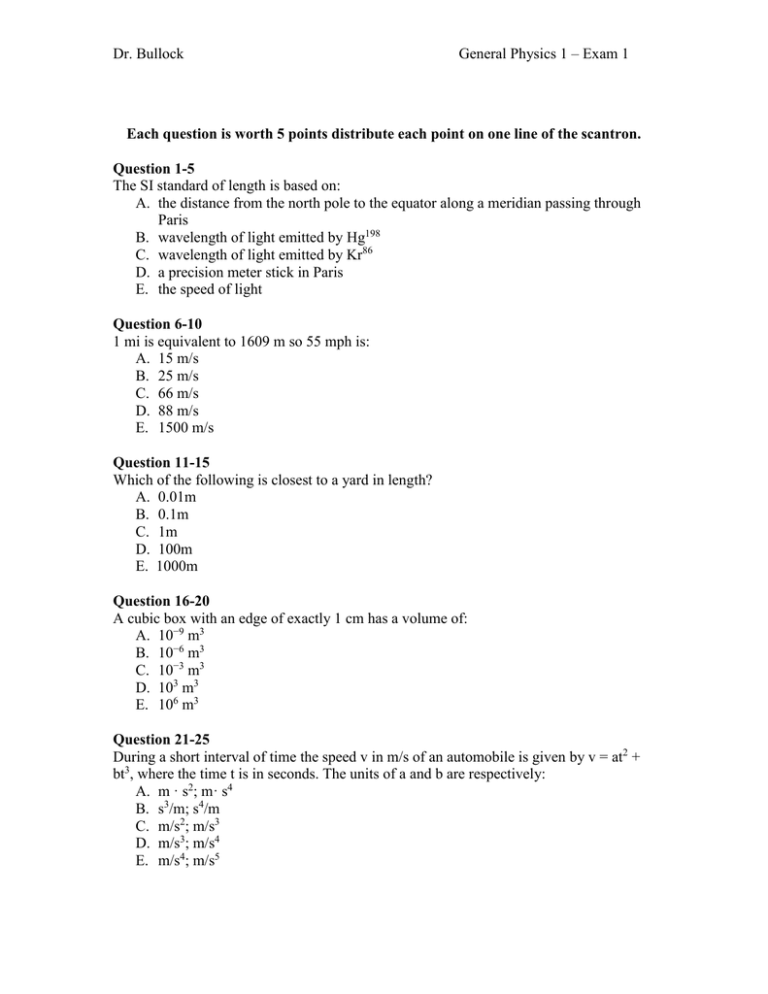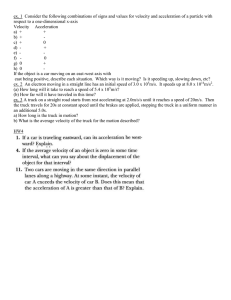Document 15232715
advertisement

Dr. Bullock General Physics 1 – Exam 1 Each question is worth 5 points distribute each point on one line of the scantron. Question 1-5 The SI standard of length is based on: A. the distance from the north pole to the equator along a meridian passing through Paris B. wavelength of light emitted by Hg198 C. wavelength of light emitted by Kr86 D. a precision meter stick in Paris E. the speed of light Question 6-10 1 mi is equivalent to 1609 m so 55 mph is: A. 15 m/s B. 25 m/s C. 66 m/s D. 88 m/s E. 1500 m/s Question 11-15 Which of the following is closest to a yard in length? A. 0.01m B. 0.1m C. 1m D. 100m E. 1000m Question 16-20 A cubic box with an edge of exactly 1 cm has a volume of: A. 10−9 m3 B. 10−6 m3 C. 10−3 m3 D. 103 m3 E. 106 m3 Question 21-25 During a short interval of time the speed v in m/s of an automobile is given by v = at2 + bt3, where the time t is in seconds. The units of a and b are respectively: A. m · s2; m· s4 B. s3/m; s4/m C. m/s2; m/s3 D. m/s3; m/s4 E. m/s4; m/s5 Dr. Bullock General Physics 1 – Exam 1 Question 26-30 Suppose A = BnCm, where A has dimensions LT (where L means length and T means time), B has dimensions L2T−1, and C has dimensions LT2. Then the exponents n and m have the values: A. 2/3; 1/3 B. 2; 3 C. 4/5; −1/5 D. 1/5; 3/5 E. 1/2; 1/2 Question 31-35 A particle moves along the x axis from xi to xf . Of the following values of the initial and final coordinates, which results in a negative displacement? A. xi = 4m, xf = 6m B. xi = −4m, xf = −8m C. xi = −4m, xf = 2m D. xi = −4m, xf = −2m E. xi = −4m, xf = 4m Question 36-40 A car travels 40 kilometers at an average speed of 80km/h and then travels 40 kilometers at an average speed of 40km/h. The average speed of the car for this 80-km trip is: A. 40km/h B. 45km/h C. 48km/h D. 53km/h E. 80km/h Question 41-45 A drag racing car starts from rest at t = 0 and moves along a straight line with velocity given by v = bt2, where b is a constant. The expression for the distance traveled by this car from its position at t = 0 is: A. bt3 B. bt3/3 C. 4bt2 D. 3bt2 E. bt3/2 Dr. Bullock General Physics 1 – Exam 1 Question 46-50 Each of four particles move along an x axis. Their coordinates (in meters) as functions of time (in seconds) are given by particle 1: x(t) = 3.5 − 2.7t3 particle 2: x(t) = 3.5 +2.7t3 particle 3: x(t) = 3.5 +2.7t2 particle 4: x(t) = 3.5 − 3.4t − 2.7t2 Which of these particles have constant acceleration? A. All four B. Only 1 and 2 C. Only 2 and 3 D. Only 3 and 4 E. None of them Question 51-55 A car, initially at rest, travels 20 m in 4 s along a straight line with constant acceleration. The acceleration of the car is: A. 0.4 m/s2 B. 1.3 m/s2 C. 2.5 m/s2 D. 4.9 m/s2 E. 9.8 m/s2 Question 56-60 At a stop light, a truck traveling at 15 m/s passes a car as it starts from rest. The truck travels at constant velocity and the car accelerates at 3 m/s2. How much time does the car take to catch up to the truck? A. 5 s B. 10 s C. 15 s D. 20 s E. 25 s Question 61-65 A ball is in free fall. Its acceleration is: A. downward during both ascent and descent B. downward during ascent and upward during descent C. upward during ascent and downward during descent D. upward during both ascent and descent E. downward at all times except at the very top, when it is zero Dr. Bullock General Physics 1 – Exam 1 Question 66-70 A projectile is shot vertically upward with a given initial velocity. It reaches a maximum height of 100 m. If, on a second shot, the initial velocity is doubled then the projectile will reach a maximum height of: A. 70.7 m B. 141.4 m C. 200 m D. 241 m E. 400 m Question 71-75 Consider the following five graphs (note the axes carefully). Which of these represents motion at constant speed? A. IV only B. IV and V only C. I, II, and III only D. I and II only E. I and IV only Question 76-80 If A = (6m)i − (8 m)j then 4 A has magnitude: A. 10m B. 20m C. 30m D. 40m E. 50m Dr. Bullock General Physics 1 – Exam 1 Question 81-85 A vector in the xy plane has a magnitude of 25m and an x component of 12m. The angle it makes with the positive x axis is: A. 26◦ B. 29◦ C. 61◦ D. 64◦ E. 241◦ Question 86-90 Let A = (2m) i +(6 m) j −(3 m) k and B = (4m) i +(2 m) j + (1m) k. The vector sum S = A+B is: A. (6 m) i + (8 m) j − (2 m) k B. (−2m) i + (4 m) j − (4 m) k C. (2 m) i − (4 m) j + (4 m) k D. (8 m) i + (12 m) j − (3 m) k E. none of these Question 91-95 In the diagram, A has magnitude 12m and B has magnitude 8m. The x component of A + B is about: A. 5.5m B. 12m C. 7.6m D. 14m E. 15m Question 96-100 Let A = (2m) i + (6 m) j − (3 m) k and B = (4m) i + (2 m) j + (1 m) k. Then A · B = A. (8 m) i + (12 m) j − (3 m) k B. (12 m) i − (14 m) j − (20 m) k C. 23m2 D. 17m2 E. none of these Dr. Bullock SHOW ALL YOUR WORK! General Physics 1 – Exam 1 NAME At the instant the traffic light turns green, an automobile starts with a constant acceleration of 2.2 m/s2. At the same instant a truck, traveling with a constant speed of 9.5 m/s, overtakes and passes the automobile. (a) How far beyond the traffic signal will the automobile overtake the truck? (b) How fast will the automobile be traveling at that instant? (10 POINTS) Dr. Bullock General Physics 1 – Exam 1 SHOW ALL YOUR WORK! NAME Draw and label the following vectors in the space provided: A 3xˆ 5 yˆ B 4 xˆ 2 yˆ Next add vectors A and B graphically in the space provided and label this vector C. Using the vector dot product find the angle between A and B.(show your work) Calculate the vector cross product: A X B. (show your work).



